Menu
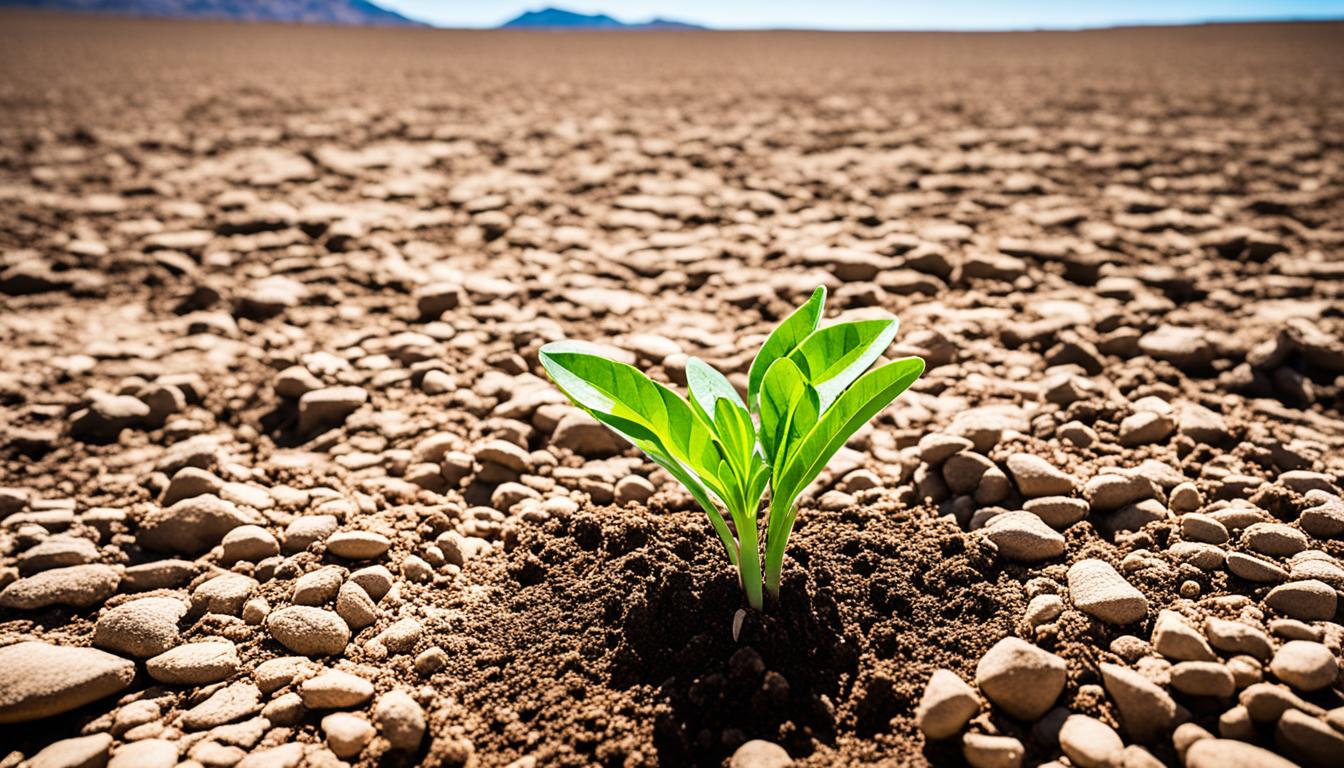
Did you know soil stores 3.1 times more carbon than the air does? It holds about 2500 gigatons (GT) of carbon, out of a total of 3170 GT on land. This shows how important soil is in our fight against climate change. Healthy soil supports life in many ways, from growing food to helping with water movement. It’s not just vital for a clean environment, it also provides a home for various plants and animals.
Keeping carbon in the ground is key to making soil healthier. This is crucial for reducing the effects of global warming. When we grow the carbon storage in soil, we help fight climate change. Soil has more carbon than the air, highlighting why we should care for it. Good soil management is critical for protecting our planet.
Soil carbon sequestration is a way to take carbon dioxide out of the air. It puts it into the soil using things like plant leftovers. This process helps to reduce the amount of CO2 in the air. It’s a cost-friendly way to fight climate change.
Soil carbon sequestration changes CO2 into soil carbon. It happens mainly when plants use CO2 in photosynthesis. These plants turn CO2 into useful stuff. Then, they leave this stuff on the ground when they die.
Moreover, these dead plants and other organic materials help store the carbon in the earth. There are huge amounts of carbon in soil. In fact, soil holds a lot more carbon than the air does.
The science of storing carbon in soil is complex but fascinating. It’s about how nature captures carbon and stores it in the ground. Plant leaves and roots, along with some types of soil, make up a big carbon store.
This store is more than three times bigger than the carbon in the air. How we use the land can make this carbon store even bigger.
Soil health is vital for farming and our environment. It’s a key part of nature, helping plants grow and filtering water. It also captures carbon. So, good soil means better farming, nature protection, and our own health.
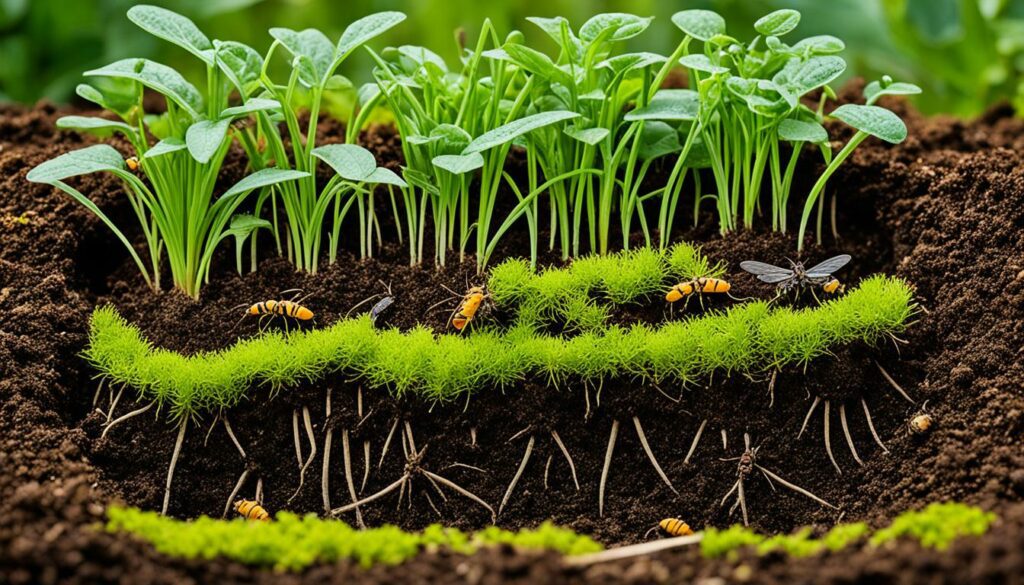
Soil is much more than dirt. It’s alive, full of tiny life forms. These help nutrients move around, clean our water, and fight climate change by locking up carbon. The secrets lie in its mix of dead plants, rocks, air, and water.
Keeping soil well means more carbon stays in the ground. This helps nature and us in many ways, like dealing with too much or too little water. Experts from places like the California Climate Hub show using special dirt can make farming better and the land stronger.
Better soil also fights climate change by holding more carbon. This makes plants tougher, so they fight off bugs and sickness. As California aims to stop adding to climate change by 2045, using our land smartly is key.
So, putting effort into our soil is a smart move. It helps us, nature, and the future.
Carbon sequestration in soil is about the life under our feet. Photosynthesis is key. It changes CO2 into compounds that feed plants and store carbon. So, it helps both plant growth and locks away carbon.
Plants need photosynthesis to lock away carbon in the ground. They take in CO2 and turn it into food. This food is then sent to the roots. There, it feeds soil life, like microbes, by producing root exudates – sugars and acids.
Microbes in the soil are crucial. They help turn plant leftovers into stable carbon. As these microbes break down old plants and sugars, they create soil that’s rich in nutrients. This rich soil is better at holding onto water and feeding new plants.
Keeping the soil healthy means disturb it less and keep it covered. Less disturbance means less carbon escapes as erosion or from decaying plant matter. A covered soil gets fresh food from plants, improving its ability to store carbon.
| Component | Impact on Carbon Sequestration |
|---|---|
| Photosynthesis | Converts atmospheric CO2 into organic compounds |
| Root Exudates | Provide substrate for soil microbes |
| Soil Microbes | Transform organic matter into stable soil carbon |
| SOM | Improves soil quality and water retention |
Soil can store a lot of carbon, making it key in managing global carbon. It holds about 2500 gigatons of carbon, far more than our atmosphere. This shows soils are vital for fighting climate change.
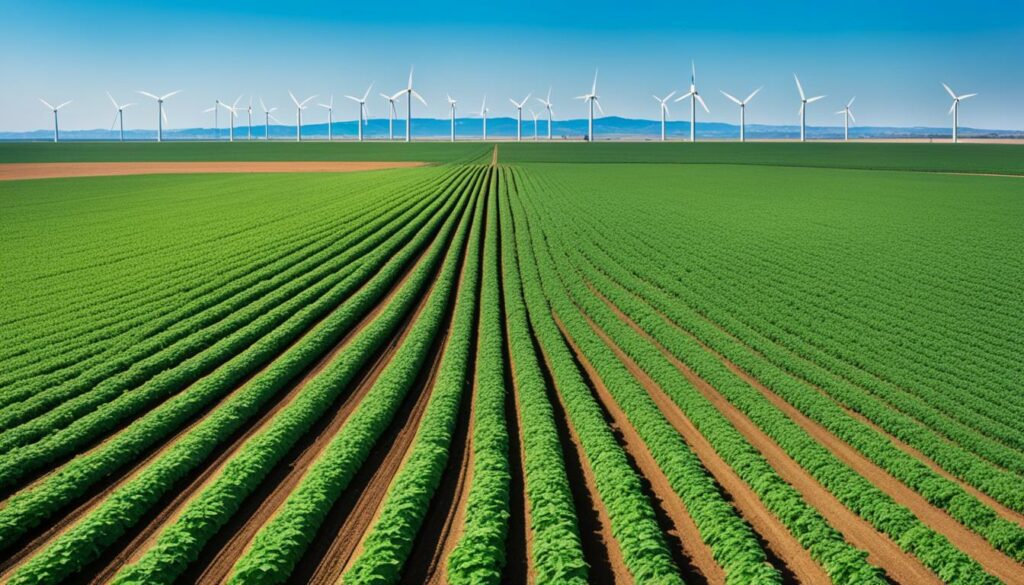
Many things affect how much carbon soil can keep. This includes the weather, what plants grow there, and how the soil is arranged. How much carbon soil can store is also linked to how much organic matter it has.
Soil lumps, or aggregates, have a big role in storing carbon. They form when soil bits stick together, keeping carbon safe for longer. By using methods like not ploughing the ground and planting cover crops, we can make more of these lumps. This helps soil keep more carbon, fighting climate change.
| Component | Carbon (GT) |
|---|---|
| Total C in Terrestrial Ecosystems | 3170 |
| Soil Carbon Storage | 2500 |
| Organic Soil Carbon | 1550 |
| Inorganic Soil Carbon | 950 |
| Atmospheric Carbon | 800 |
Taking good care of soil can help save a lot of carbon. With better farm methods, soils could keep a billion more tons of carbon each year. Well-looked-after grasslands, for example, can keep as much carbon as they did before. This is how we can make a difference against climate change.
Agriculture has greatly affected soil carbon levels. Over the years, activities like deforestation and intensive ploughing have decreased soil organic carbon. This has led to major carbon losses and harmed the structure of the soil.
Cultivated soils have lost as much as 70 percent of their original organic carbon. This massive decline shows why it’s vital to restore this carbon. Every year, agriculture produces 5.0 to 5.8 GtCO2-equivalents. This makes good soil carbon management practices crucial.
Today, agriculture is turning to sustainable solutions to counter these past losses. Techniques like reduced tillage, crop diversification, and using organic amendments aim to keep carbon in the soil. These approaches also cut down agriculture’s carbon impact.
| Agricultural Practice | Impact on Soil Organic Carbon | Cost Implications |
|---|---|---|
| Reduced Tillage | Promotes soil structure, increases SOC | Moderate initial investment |
| Crop Diversification | Enhances biodiversity, boosts carbon absorption | Variable based on crop type |
| Organic Amendments | Improves soil fertility, sequesters carbon | Approximately $100 per ton of CO2 |
By 2030, it’s estimated that better soil practices could reduce up to 5.3 GtCO2 annually. This shows the vital role of sustainable farming in combating soil carbon loss.
To boost soil carbon sequestration, using advanced techniques is key. No-till farming and cover crops are two standout methods. They are very effective.
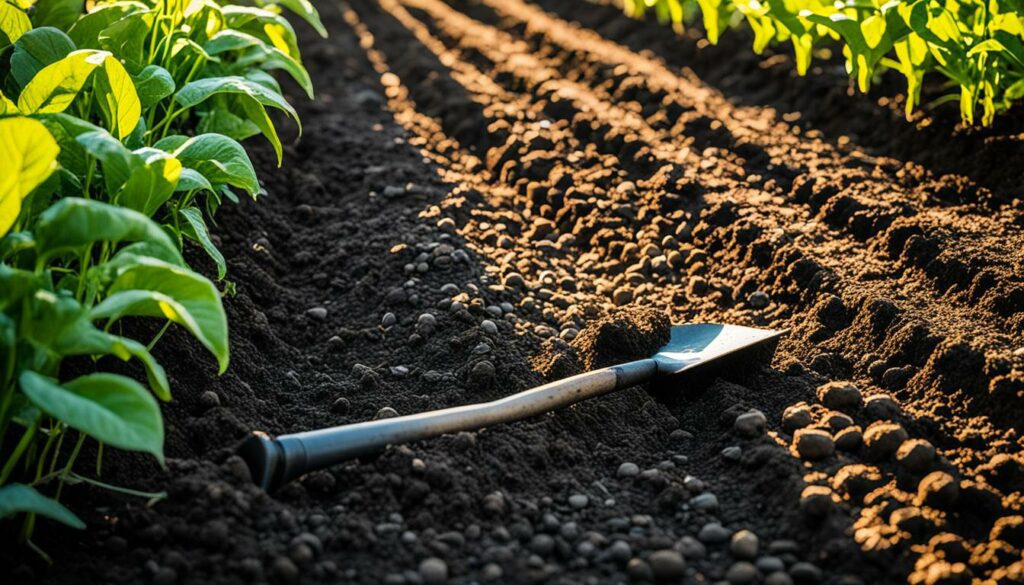
No-till farming is at the forefront of soil carbon sequestration methods. It helps by not disturbing the soil. This reduces erosion, keeps the soil’s structure in good shape, and stores more carbon. Recent studies show, up to three times more carbon is stored in less-disturbed soils. This method helps the soil stay healthy. It also uses natural processes to lock carbon away.
Another powerful technique is planting cover crops. These include clover and rye. They add organic material to the soil regularly, boosting carbon sequestration. Croplands can store a lot more carbon, around 0.90 to 1.85 billion metric tons, each year using this method. Cover crops also make the soil better at taking in and keeping water. This helps during dry spells and keeps the soil healthy. They increase the soil’s fertility by encouraging the right kind of life in the soil.
All these techniques combined offer a great way to have more carbon in the soil. They are a sustainable choice for better, carbon-rich soils. Using them can help meet California’s goal to be carbon neutral by 2045.
In fighting climate change, soil carbon initiatives are key. People around the world see the need to increase soil carbon to reduce CO2 in the air. The 4p1000 Initiative and the RECSOIL Programme show how countries are working together on this.
The 4p1000 Initiative started at COP21 under the UNFCCC. It wants to raise the world’s soil carbon by 0.4% each year. This small increase can help a lot by lowering CO2 emissions. They’ve risen massively over 12,000 years due to farming.
The plan is to use farming that doesn’t disturb the soil a lot and grows various plants. This makes the soil keep more carbon.
The RECSOIL Programme is a big step to add carbon back to the soil worldwide and make soil healthier. It looks at the good things for nature and farming that come from keeping more carbon in the soil. The idea is to find ways that are cheap to do but really help the planet.
The IPCC found that using these cheap but good ways could remove a lot of CO2 from the air every year. They say up to 3.8 billion tons at a cost of $100 each ton. This means these ways are a good choice for many places.
Adding these plans to bigger actions for the environment shows how important they are. The USDA putting $10 million into checking soil carbon on some areas is a big step. And with the help of the CRP and the Growing Climate Solutions Act, things are looking up. It all points to a future where we’re better at keeping carbon away from the air.
Effective soil carbon management needs strong soil carbon sequestration policy and market perks. These are key to making farmers boost their soil carbon storage. About 50% of potential green areas are now farms. This shows how farming has changed land use and the need for smart soil carbon saving ways.
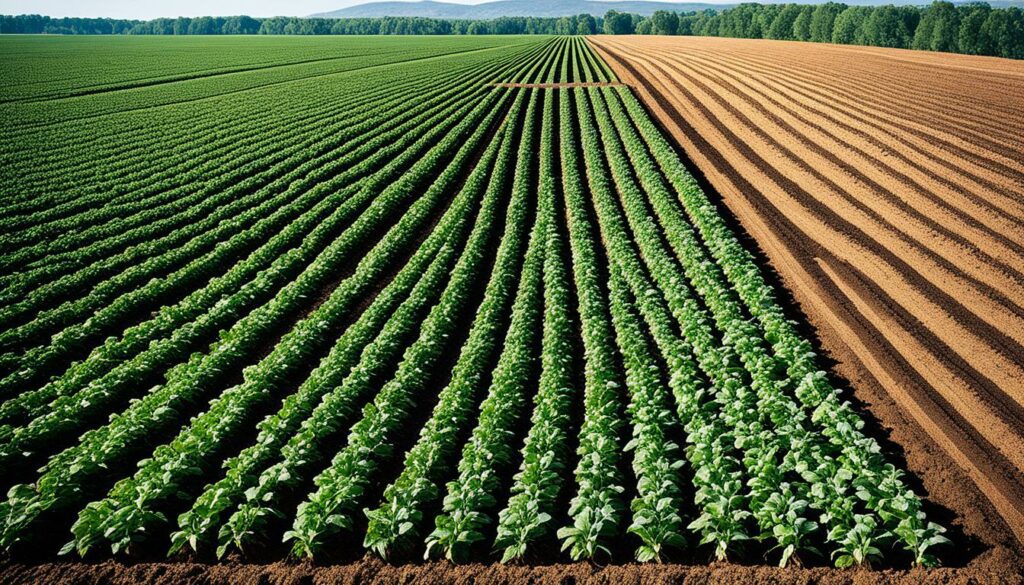
Agricultural incentives are crucial for getting farmers to store more carbon in soil. Worldwide, policies are offering ways to get farmers interested in better soil carbon practices. This includes payments for those already trying to manage soil carbon well. It helps create a good setting for growing the soil carbon storage.
Making specific economic plans is key for farmers to use soil carbon sequestering methods widely. Companies in the United States, like Indigo and Nori, use carbon offset rules from groups such as Verified Carbon Standard and Climate Action Reserve. Since 2017 and 2019, Nori and Indigo have offered programs mainly for traditional farming in certain parts of the country. Yet, more work is needed to cover all types of farming.
Supporting financially and offering perks can make it easier for farmers to adopt new practices. This helps tackle worries about how new methods work and their costs. Things like the USDA’s Conservation Stewardship Program and Conservation Reserve Program are very helpful. They offer big chances for farmers to make changes.
| Program | Start Year | Focus | Region | Farmers’ Motivation |
|---|---|---|---|---|
| Nori | 2017 | Carbon offsets | Midwest and South | Environmental co-benefits |
| Indigo | 2019 | Carbon offsets | Midwest and South | Environmental co-benefits |
To meet our climate targets, we must blend solid policy on soil carbon sequestration with real-world agriculture incentives. This mix will boost both economy and environment. Making soil carbon key in our climate fight helps cut down emissions and makes farmlands stronger. It also brings more environmental gains.
Soil carbon sequestration is a great way to fight climate change, but it faces many problems. The big issue is measuring how much carbon is stored in the soil. To make sure we get real results and honest carbon credits, we need accurate tools. But, it’s tough because soils vary from place to place, as do the climate and how the land is managed.
Finding out how much carbon the soil traps is key, but the methods are hard and can cost a lot. In the US, making money from soil carbon needs the price to be above $30 per acre each year. But, the current price is only $12.30 per metric tonne of CO2, making things difficult. To get more people involved, we need to lower the costs of measuring.
Different places have varying abilities to store soil carbon. For example, lands used for cattle breeding saw a 2 to 3% increase in carbon each year. But vineyards in another place only went up by 0 to 1%. This makes it hard to set general rules for everyone to follow. Also, some places just can’t store more carbon no matter what they do, depending on the soil and climate.
Farmers signing up for soil carbon projects must commit for a long time. This might hinder their ability to use or sell their lands later. Also, adding carbon to soils might increase nitrous oxide, which could cancel the good of storing carbon.
Looking at the bigger picture, projects in Australia might pay out big, but it’s still just a small part of what farms there will make. Financial limits and the work involved might not encourage many to join in.
Soil carbon sequestration is good for the planet, but we still need to deal with many issues. Tackling these challenges will require ongoing study and support from our policies.
Soil carbon sequestration is great for the planet. It helps fight climate change and keeps our environment healthy. This technique takes CO2 from the air and locks it in the ground for many years.
There are different ways to do this. For example, when we actively work to restore lands, we boost soil carbon storage by over 40%. In contrast, letting nature take its course increases storage by nearly 40% in China.
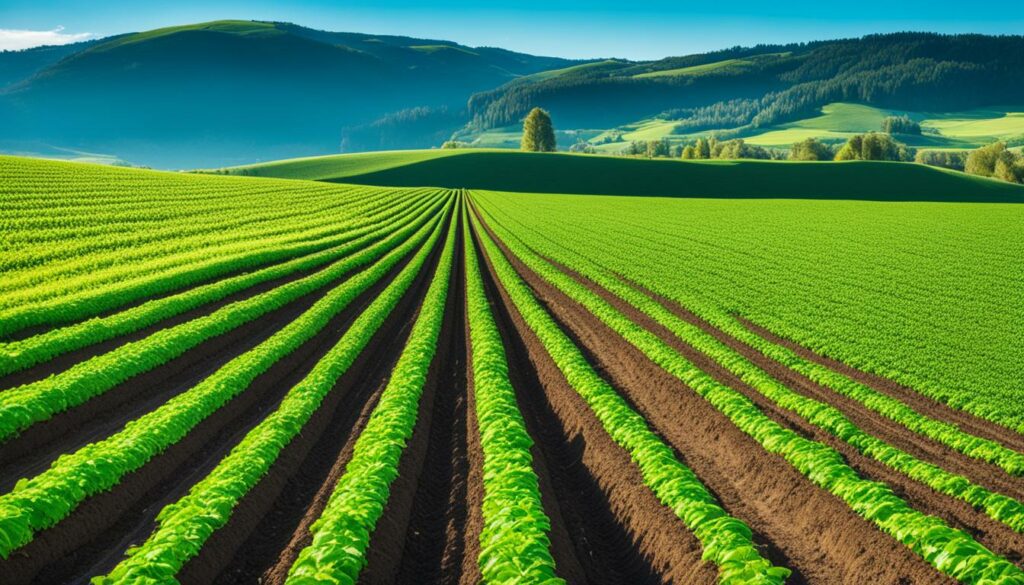
Soil is a key player in the fight against climate change. Natural regeneration stands out by significantly improving soil’s ability to store carbon. Even though actively restoring lands helps, it’s not as effective as letting nature do its work.
How much carbon the soil can hold and how deep it is are important. If the soil has over 5.1 g of carbon per kilogram, restoring it works better than letting it regenerate naturally. A depth of 31.1 cm shows when letting the soil regenerate is more effective.
Boosting soil carbon means healthier soil. This makes the soil better for plants and animals. It also helps farmers grow more food and deal with changes in weather.
Some things, like the soil’s carbon and how deep it is, always matter. But, the time it takes to restore the land and how dry the area is don’t have as big of an effect. Still, we need to think about these things when we’re working to make the soil healthier.
Scientists are working hard to unlock the future potential of soil carbon sequestration. They are diving deep into research to understand how carbon stores in soil. This understanding is crucial for making the most out of soil’s carbon storage.
One big challenge we face is that soil carbon is not stored permanently. The carbon in soil can go back into the air because of changes in how the land is used or the climate. But, using special models helps us check how much carbon we’re saving in the soil. This is a cheaper way than measuring directly.
New ways to manage soil are key to keeping more carbon in it. There are better farming methods and new technologies for understanding soil carbon levels. Also, the way we count greenhouse gases and their impact is getting better. All these efforts aim to make our farming more sustainable and to cut down the world’s greenhouse emissions. Methods like keeping the soil covered and planting trees can store more carbon for the long run. This also makes the soil healthier.
To unlock soil’s full potential for storing carbon, it’s crucial to keep up with new soil management methods. By adopting these new practices, we ensure soil’s pivotal role in fighting climate change.
It’s key to understand how soil carbon stores differ in various climates. This knowledge helps in making successful plans. The levels of soil carbon and how they change depend on climate, plant life, and the work of tiny soil organisms.
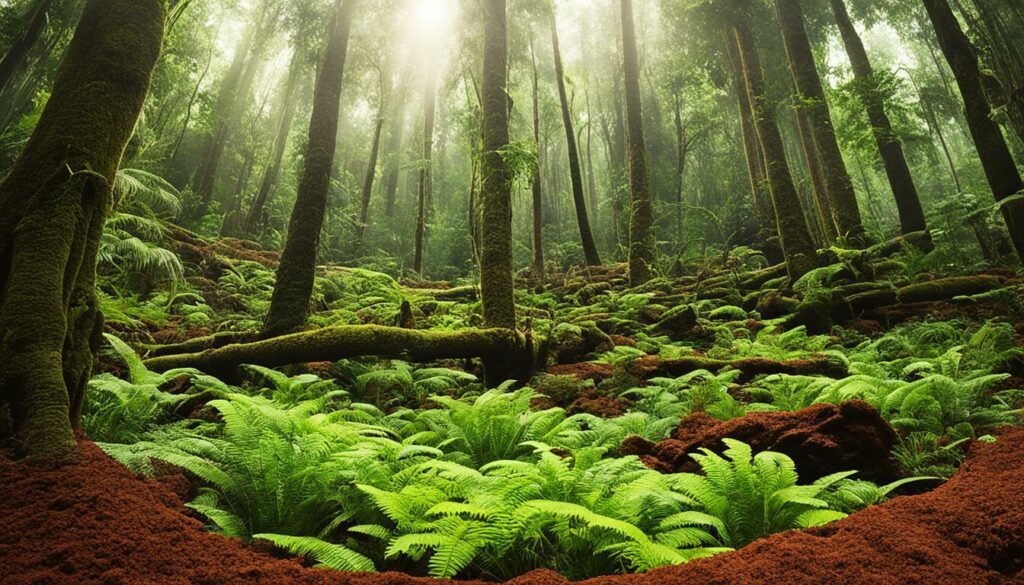
In cooler areas, soil keeps more carbon because dead plants break down slower. The low temperatures and steady rain reduce the activity of tiny organisms. This makes the carbon stay in the soil longer. These places also have well-structured soil, which helps keep carbon locked away.
Warm, wet places lose their carbon stores quickly because stuff rots fast. This is a big hurdle for saving carbon. But, tropical lands grow lots of plants and quickly break down old stuff. With the right methods, like planting cover crops and not damaging the soil, they can keep more carbon.
Adapting to different climates is vital for saving carbon in the soil. We need specific plans for each type of place, considering the natural variations. This way, we can save as much carbon as possible everywhere.
| Region | Key Characteristics | Carbon Sequestration Dynamics |
|---|---|---|
| Temperate | Cooler temperatures, moderate precipitation, well-structured soils | Slower decomposition rates, larger carbon stocks, stable storage |
| Tropical | Warmer temperatures, high moisture levels, rapid organic turnover | Fast decomposition rates, high primary productivity, tailored strategies required |
Engaging communities and farmers through educational initiatives is key. This approach helps them understand and commit to sustainable farming. Workshops teach practical techniques to capture carbon in the soil.
Educational projects are the key to getting communities involved. They teach people about carbon sequestration and how it works in farming. This helps everyone make smart choices about how they use their land.
Across the world, governments are giving out rewards to farmers who store carbon in their soil. AGCO even spent $5 million on education in Zambia to support these efforts. It’s believed that soil could lock away 5 billion tons of carbon each year. This shows how powerful education can be in fighting climate change.
Practical lessons turn what’s learned in theory into active steps. Farmers get to try hands-on techniques for managing soil carbon. This way, they can learn and do at the same time.
These workshops help farmers gain skills that make complex issues, like getting carbon offset credits, easier. A recent study echoed that US farmers found these market processes complicated since 2017.
Groups like Nori and Indigo show farmers their strategies. These are based on solid standards and proven to work in regions like the Midwest. Farmers see real, positive changes, making them more likely to stick with these new practices.
The way we manage soil carbon affects our food supply globally. If we focus on storing more soil organic carbon (SOC) and inorganic carbon (SIC), we can boost how much food we grow. There’s a huge amount of carbon in our soil, and unlocking it can help feed the world better.
Boosting the carbon in soils can improve crop yields a lot. just 1 extra ton in degraded soil can increase wheat by 20 to 40 kilograms per hectare. For maize, this means 10 to 20 extra kilograms and cowpeas, a staple crop, by 0.5 to 1 kilogram. This extra food is crucial for feeding more people as the population grows.
Sustainable farming methods also help the soil and the crops. Things like leaving soil undisturbed (conservation tillage), using mulch, planting trees near crops (agroforestry), and rotating different kinds of crops can keep soil healthy.
This doesn’t just mean better food. It also helps fight climate change by capturing about 5 to 15% of the world’s dangerous emissions every year.
In short, focusing on soil carbon is key for both food and the environment. It can make our food supply safer and the planet healthier.
Soil carbon sequestration moves carbon dioxide from the air into the soil. It happens through remains of crops and other organic things. This way of storing carbon boosts soil health and fights climate change.
The science shows how soil and plants interact. By using photosynthesis, plants take in carbon from the air. With good land management, the soil can trap even more carbon.
Soil is a home for many living things. It filters water, recycles nutrients, and keeps carbon safe. All of this helps a lot of different plants and animals to live and keeps nature in balance.
Good soil moves nutrients well, supports many species, boosts farming, and keeps our air and water clean. It’s Key for strong nature and healthy environments.
Plants take in CO2 from the air through photosynthesis and turn it into organic stuff. This organic matter goes into the soil. It lets soil microbes keep carbon locked away in the soil.
Soil microbes change dead plants into soil carbon that stays locked up. Their work is what makes soil so good at storing carbon.
Weather, types of plants, soil structure, and how we look after the land matter a lot. They decide how much carbon soils can keep safe.
Soil aggregates protect the carbon inside from breaking down too fast. This is a good way to keep carbon in the soil for a long time. Farming with less digging and more plant covers helps soil do this better.
Cutting down forests, digging the soil, and only growing one crop have taken a lot of carbon from the soil. These actions hurt the soil making it harder to store carbon.
Practices like not digging the soil (reduced tillage), planting many different crops, and adding organic things to the soil help keep carbon in the soil. They make farming better for the planet.
By not digging the soil, no-till farming stops soil from washing away. It helps keep the soil rich in carbon, which is good for the planet.
Cover crops add fresh material to the soil all the time. This helps store more carbon. They also make the soil healthier and better at keeping carbon safe.
These projects show how many countries want to keep more carbon in their soils. The 4p1000 Initiative wants to increase soil carbon around the world to help tackle climate change. RECSOIL helps make soils healthier everywhere.
Money, carbon trading, and support from governments can push farmers to use soil-friendly methods. This helps them take better care of the soil.
Knowing how much carbon is in the soil and what helps keep it there is tough. Weather and how we use the land can also make storing more carbon harder. We need to keep learning to overcome these issues.
By locking up CO2 from the air, soil can help fight climate change. It’s a big step in the right direction.
New ideas and technology are making it easier to keep carbon in the soil for a long time. These changes aim to help the soil store even more carbon.
In cooler places, more carbon can be stored, but it also breaks down slower. Hotter, wetter areas see carbon decompose quickly. Strategies need to vary to fit each place.
Teaching local people and farmers about better soil care is key. Their efforts are vital for keeping the land healthy and fertile.
Healthier soil and more carbon in it help grow more food. This makes farming able to stand up to changes in the weather and feeds more people.